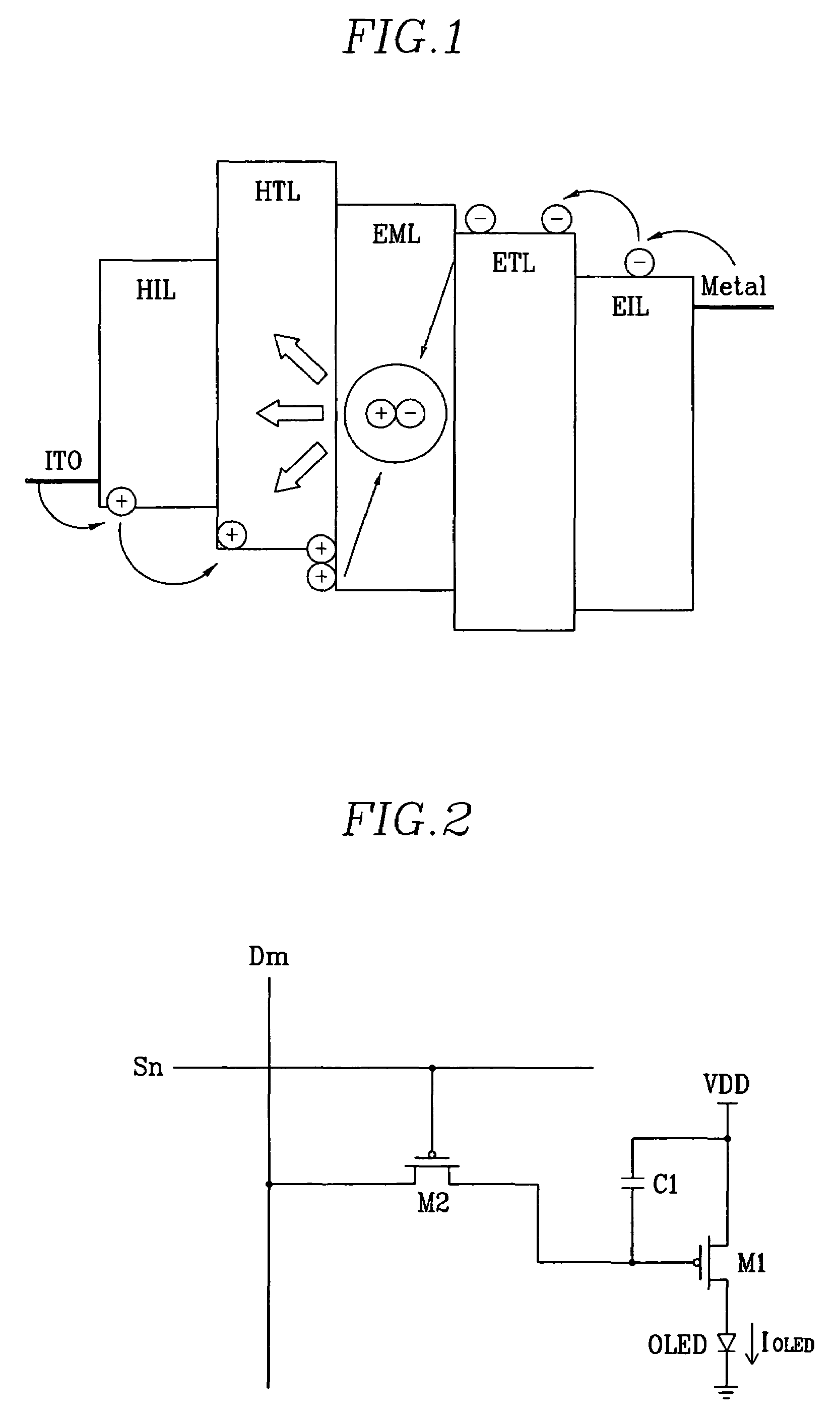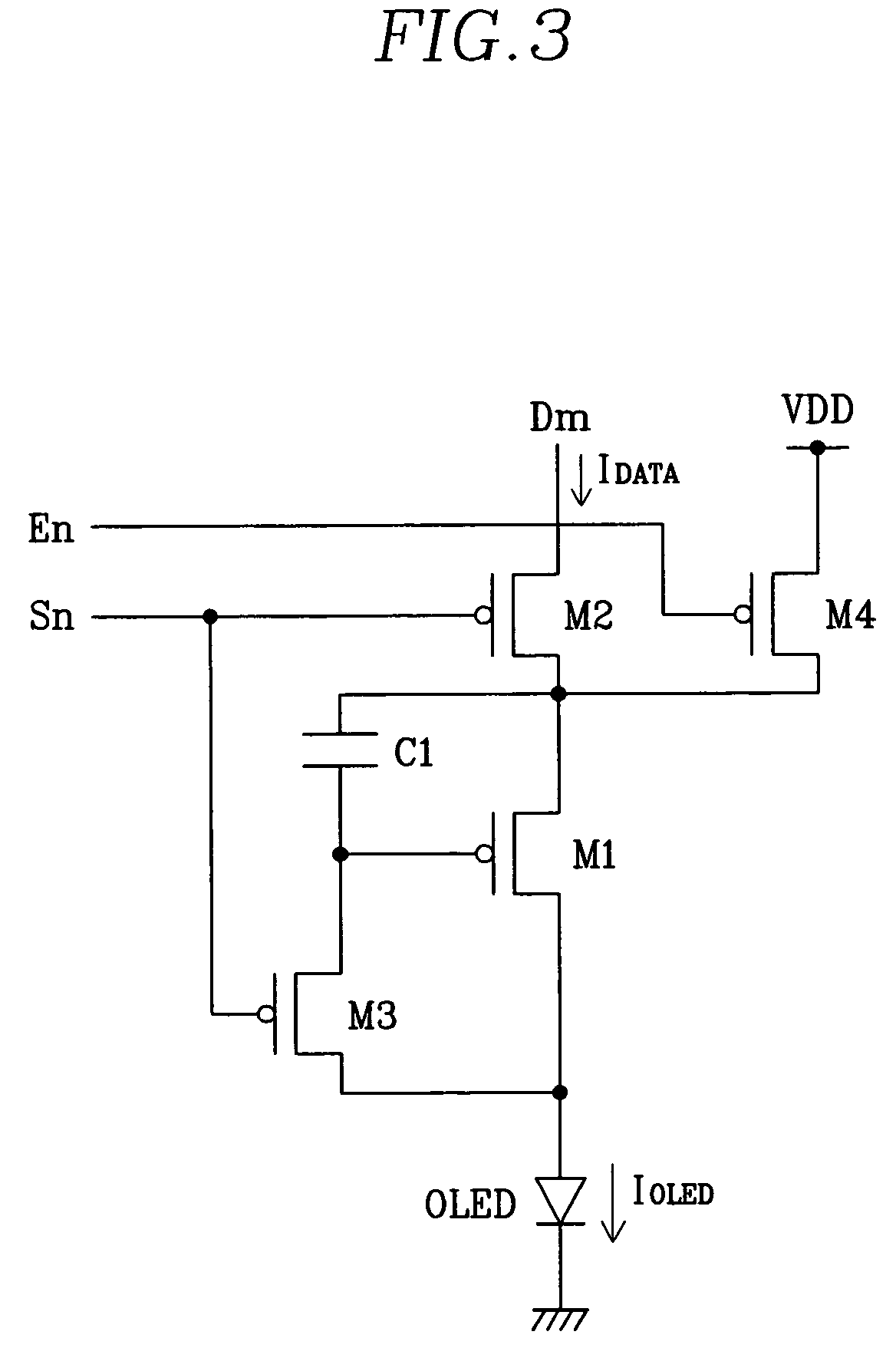Light emitting display, display panel, and driving method thereof
a technology of light-emitting display and display panel, which is applied in the direction of static indicating devices, instruments, solid-state devices, etc., can solve the problems of difficult to obtain high gray, difficult to represent high gray, and the control of the pixel circuit by fine current i/sub>data problem requires a lot of time to charge the data line, so as to achieve fast timing and high uniformity between the threshold voltages of the first and second transistors
- Summary
- Abstract
- Description
- Claims
- Application Information
AI Technical Summary
Benefits of technology
Problems solved by technology
Method used
Image
Examples
first embodiment
[0041]Next, referring to FIG. 6, an operation of the pixel circuit according to the present invention will be described in detail.
[0042]As shown, in interval T1, transistor M5 is turned on by low-level select signal SEn to couple the gate of transistor M1 and the gate of transistor M2. Transistor M3 is turned on by select signal SEn to have data current IDATA from data line Dm flow to transistor M2. Data current IDATA can be given as Equation 3, and the gate voltage VG3(T1) at transistor M2 in interval T1 is determined from Equation 3. Since the gate of transistor M1 and the gate of transistor M2 are coupled, the gate voltage VG1(T1) at transistor M1 corresponds to the gate voltage VG3(T1) at transistor M2.
[0043]IDATA=12μ2Cox2W2L2(VGS-VTH2)2=12μ2Cox2W2L2(VDD-VG2(T1)-VTH2)Equation3
[0044]where μ2 is electron mobility, Cox2 is oxide capacitance, W2 is a channel width, L2 is a channel length, VTH2 is a threshold voltage of transistor M2, and VDD is a voltage supplied to trans...
second embodiment
[0058]FIG. 7 shows an equivalent circuit of a pixel circuit according to the present invention, and FIG. 8 shows a driving waveform for driving the pixel circuit of FIG. 7.
[0059]As shown in FIG. 7, the pixel circuit according to the second embodiment further includes scan line Cn in the pixel circuit of FIG. 5. Transistor M5 has a gate coupled to scan line Cn, and couples the gate of transistor M1 to the gate of transistor M2 in response to control signal CSn from scan line Cn.
[0060]Referring to FIG. 8, since turn-on and turn-off timing problem of transistors M3 and M5 can occur in the first embodiment, control signal CSn is set to be low-level prior to select signal SEn. In this instance, a delayed signal of control signal CSn can be used as a select signal SEn.
[0061]In detail, transistor M5 is previously turned on by control signal CSn to couple the gate of transistor M1 and the gate of transistor M2, and transistor M3 is turned on by select signal SEn to transmit data current IDA...
PUM
 Login to View More
Login to View More Abstract
Description
Claims
Application Information
 Login to View More
Login to View More - R&D
- Intellectual Property
- Life Sciences
- Materials
- Tech Scout
- Unparalleled Data Quality
- Higher Quality Content
- 60% Fewer Hallucinations
Browse by: Latest US Patents, China's latest patents, Technical Efficacy Thesaurus, Application Domain, Technology Topic, Popular Technical Reports.
© 2025 PatSnap. All rights reserved.Legal|Privacy policy|Modern Slavery Act Transparency Statement|Sitemap|About US| Contact US: help@patsnap.com



